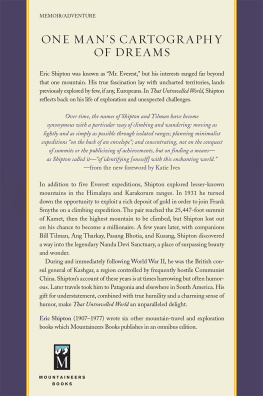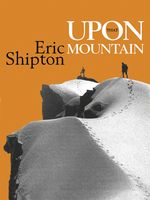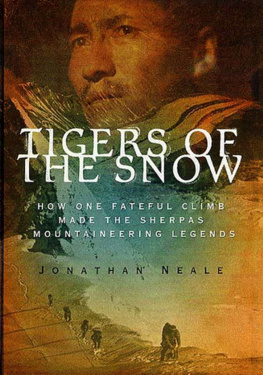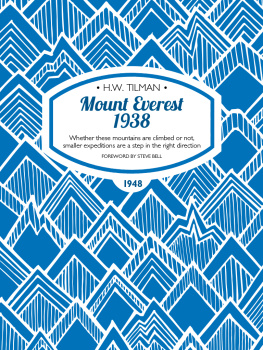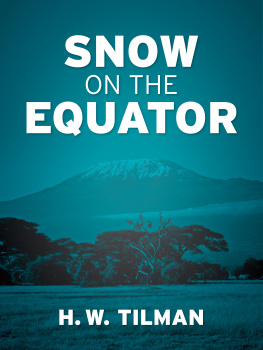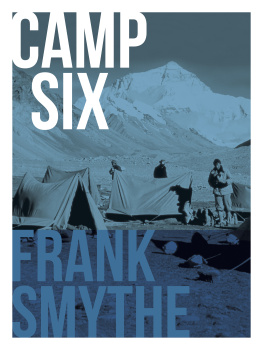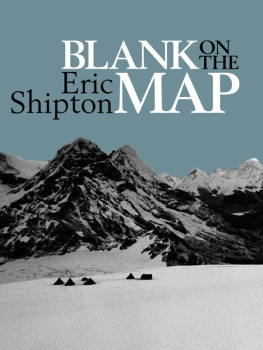BLANK ON THE MAP
Eric Shipton
www.v-publishing.co.uk
CONTENTS
SHIPTONS LEGACY FOR MOUNTAINEERS
Hugh Ruttledge
When Mr Shipton honoured me by an invitation to write a foreword to his book, I accepted with a particular sense of both privilege and opportunity; of privilege because the book is an epic of mountaineering exploration, of opportunity because so little is yet known of three aspects of Himalayan travel: the comparatively easy and inexpensive access to some of the wildest regions, the almost unlimited scope for small but thoroughly competent parties, and the amazing strength and capacity of the Sherpa porter.
I had the good fortune to serve for nearly five years in the section of the Central Himalayan chain with which this book deals. I climbed there with Sherpa, Gurkha, Bhotia and Kumaoni as well as British companions; and we made four attempts to enter the great Nanda Devi Basin, as better mountaineers had done before us. It is therefore with some knowledge of the facts that I acclaim the success gained by Messrs Shipton and Tilman and their three Sherpa comrades as one of the greatest feats in mountaineering history. Not only that: it has proved beyond doubt that, in these regions at any rate, a small homogeneous party, self-contained, able to live off the country, with no weak links and ably led, can go further and do more than the elaborate expeditions which have been thought necessary for the Himalaya. What a field of adventure and enterprise this throws open to young mountaineers, now that most of the other great mountain ranges of the world are but too well known.
One word of warning is perhaps necessary: work of this kind should be undertaken only by those who have attained the highest degree of mountaineering skill, judgment and endurance. Those who read this book with understanding will realise the number of tight places this party got into, where nothing but the most brilliant technical competence could have got them out alive. It is not a game for the beginner, or for the lover of flesh-pots.
The greatest feat was the successful entry into, and departure from, the inner sanctuary of the Nanda Devi Basin a place only about seventy-five miles from Almora, yet hitherto more inaccessible than the North Pole. At last men have set foot upon the slopes of the greatest mountain in the British Empire; and to them will be extended the admiration of those who have struggled and fought for it notably Dr T. G. Longstaff, who so nearly succeeded in 1907.
Less spectacular perhaps, but hardly less exacting, were the two great traverses of the Badrinath-Gangotri and the Badrinath-Kedarnath watershed, along lines famous in Hindu mythology. These were replete with all the misery that mountaineering in the monsoon season can entail, but the climbers have their reward in the completion of a task that was well worth accomplishment, and in the regard of good Hindus, in whose eyes this would be a pilgrimage of superabundant merit.
Mr Shipton has paid generous and well-deserved tribute to the three Sherpa porters who accompanied him. It is no exaggeration to say that, without men of this type, climbing the higher Himalaya would be impossible. On them are based our hopes of climbing Mount Everest, and for years to come there will be none among the Himalayan peoples to equal them as mountaineers, porters, and loyal, unselfish companions. They are well on their way to become a corps of guides as famous as the men of the Alps. In time there may be others as good there is splendid material in Kumaon, in Hunza or in Baltistan, to name a few Himalayan regions; and the humble Nepalese Dotials who served Mr Shipton so faithfully in the Rishiganga are worth their salt. At present the Sherpa holds pride of place, and his morale and esprit-de-corps are tremendous assets. Given the right leaders and they must be of the best he is unbeatable. The description of him in this book is the most understanding and delightful that has ever been written.
The lists are now set for great deeds in the Himalayan snow-fields. Messrs Shipton and Tilman have shown the way; let us hope that many will follow.
Hugh Ruttledge
Eric Shipton
by Jim Perrin
Early in 1930 a young planter in Kenya unexpectedly received a letter from an ex-soldier ten years his senior, who had settled in the colony after the Great War. The letter mentioned that its writer had done some climbing in the English Lake District on his last home leave, and asked advice about visiting the East African mountains. Its immediate results were a meeting between the two men, an initial jaunt up Kilimanjaro together, and the first ascent, later that year, of the West Ridge of Mount Kenya one of the major pre-war achievements of British alpinism.
The two men were, of course, Eric Shipton and H. W. Tilman, and their chance meeting, out in the colonies at the very beginning of the decade, led to one of the most fruitful partnerships and entrancing sagas in the history of mountain exploration. Indeed, the centrality of their role in that history throughout one of its vital phases is unarguable. The chance of their acquaintance and the magnitude of their travels aside, there is another aspect of these two men which is perhaps even more remarkable. For they were both inveterate chroniclers of their climbs and journeys, and the quality of the writings so produced places them absolutely in the forefront of mountaineering and travel literature.
For the span of their contents alone, Shiptons books are noteworthy: Nanda Devi (1936), his first, deals with the 1934 penetration up the Rishi Gorge into the Nanda Devi sanctuary in company with Tilman, as well as the two traverses of the Badrinath-Kedamath and Badrinath-Gangotri watersheds. From the moment of its first publication, for reasons to be examined below, it was regarded as one of the revolutionary texts of mountain literature, and it remains an enthralling story of hazardous and uncertain journeying with minimal resources through unknown country. Blank on the Map (1938) describes the 1937 Shaksgam survey expedition undertaken with Michael Spender, John Auden, (brothers to the poets) and Tilman an important venture into a little-known region of the Himalayas which provided a basis for much subsequent mountaineering activity in the Karakoram. (First editions of this very rare title now command fabulous prices amongst collectors.)
From 1940 to 1942 Shipton served as British Consul-General at Kashgar, in the Chinese Province of Sinkiang. During this period he completed a first volume of memoirs, entitled Upon that Mountain , published in 1943. This frank, vivid polemic set out his basic mountaineering creed, whilst also describing his early Alpine and Himalayan seasons, the series of climbs on Mount Kenya, and the four attempts on Everest and two survey-trips to the Karakoram in which he took part during the thirties. His next book was very different in tone. Mountains of Tartary (1950) is a series of light-hearted sketches of weeks or weekends seized from official consular work in the main during his second spell of office in Kashgar and spent on Bogdo Ola, Mustagh Ata, Chakragil (mountains which are again coming into vogue in the eighties since Chinas relaxation of restrictions on travel). The Mount Everest Reconnaissance Expedition 1951 (1952) was basically a photographic volume, prefaced by a succinct and entertaining narrative about this vital piece of mountain exploration, which cleared the path for John Hunts successful expedition to the mountain in 1953. The final book in this series, Land of Tempest , written in 1963, takes for theme the period of Shiptons life from 1958 to 1962 and includes accounts of three trips to Patagonia on the last of which he made the first crossing of the main Patagonian ice-cap and one to Tierra del Fuego.


